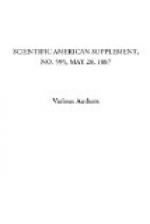The limit of movement of a punka is to be found in the man who pulls it. Twenty-four pulls a minute of a length of 36 inches give in practice a speed of 168 linear feet to the punka curtain. This speed is found to produce a current sufficiently rapid for practical purposes, and twenty-four pulls or beats per minute correspond to a length of suspending cord of fifty inches.
* * * * *
HOW TO MAKE A KITE WITHOUT A TAIL.
The following is the method of making a kite without a tail: All the calculations necessary in order to obtain the different proportions are based upon the length of the stick, A’A, employed. Such length being found, we divide it by ten, and thus obtain what is called the unit of length. With such unit it is very easy to obtain all the proportions. The bow, K’K, consists of two pieces of osier each 51/2 units in length, that form, through their union, a total length of 7 units.
[Illustration: KITE WITHOUT A TAIL.]
After the bow has been constructed according to these measurements, it only remains to fix it to the stick in such a way that it shall be two units distant from the upper end of the stick. The balance, CC’, whose accuracy contributes much to the stability of the whole in the air, consists of a string fixed at one end to the junction, D, of the bow and stick, and at the other to the stick itself at a distance of three units from the lower extremity. Next, a cord, B, is passed around the frame, and the whole is covered with thin paper.
Before raising the kite, the string, which hangs from K’, is made fast at K in such a way as to cause the bow to curve backward. This curvature is increased or diminished according to the force of the wind.
Nothing remains to be done but to attach the cord to the balance, and raise the kite.—La Nature.
* * * * *
APPARATUS FOR DRYING FLOUR.
The accompanying drawing represents a simple but effective apparatus for drying flour and ascertaining the quantity of water contained therein. It consists of four pieces, the whole being made of block tin. A is a simple saucepan for containing the water. B is the lid, which only partially covers the top of the pan, to which it is fixed by two slots, a hole being left in the middle for the placing of the vessel which contains the flour to be operated upon, and is dropped in in the same way as the pan containing the glue is let into an ordinary glue pot. C is the spout, which serves as an outlet for the steam arising from the boiling water. D is the vessel in which the flour is placed to be experimented upon; and EE are the funnels of the lid which covers the said vessel, and which serve as escapes for the steam arising from the moisture contained in the flour.
[Illustration: APPARATUS FOR DRYING FLOUR]




